David J. Eicher
| David J. Eicher | |
|---|---|
 David J. Eicher in 2010 | |
| Born |
August 7, 1961 (age 57) Oxford, Ohio, U.S. |
| Residence | Waukesha, Wisconsin, U.S. |
| Nationality | American |
| Occupation | Editor, author, producer |
| Known for | Astronomy, Civil War history |
| Notable work | Astronomy magazine, Deep Sky magazine |
| Title | Editor-in-Chief, Astronomy magazine |
| Website | http://www.davideicher.com |
David John Eicher (born August 7, 1961) is an American editor, writer, and popularizer of astronomy and space. He has been editor-in-chief of Astronomy magazine since 2002. He is author, coauthor, or editor of 23 books on science and American history and is known for having founded a magazine on astronomical observing, Deep Sky Monthly, when he was a 15-year-old high school student.[1]
Eicher is also a historian, having researched and written extensively about the American Civil War.
Early life
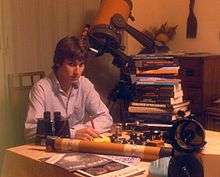
Eicher was born in Oxford, Ohio on August 7, 1961. He was born into a scientific family, the son of John H. Eicher (1921–2016), a professor of organic chemistry at Miami University in Oxford, Ohio, who as a young man was a Manhattan Project scientist, and housewife Susan Ann (née Arne) Eicher (1923–1983). His sister Nancy Eicher (born 1959) is a journalist and editor. His great uncle was Ethan Nathan Allen (1904–1993), a professional baseball player and baseball coach at Yale University whose players included George H. W. Bush. His great-great grandfather Darius Wetzel (1839–1903) fought with the 74th Ohio Infantry in the Civil War, which influenced Eicher more than a century later. He is of predominantly German, Swiss, and English ancestry, along with a small percentage of Delaware Native American.
Eicher grew up in a suburb of the small town of Oxford, with relatively dark skies overhead. He attended Hannah House Nursery School (1966), William Holmes McGuffey Laboratory School (1967–1975, a school for offspring of Miami University employees) and Talawanda High School (1976–1979), where he was involved in band activities. He was also actively interested in American history and in science, leaning toward a career as a doctor.
This changed in early 1976 when he attended a “star party” in Oxford and Eicher looked at Saturn through a telescope. He was immediately attracted to astronomy and set off exploring the sky with binoculars, joining the local astronomy club, and beginning to write for their publication when another contributor quit. Eicher had significant enthusiasm for writing about star clusters, nebulae, and galaxies — objects in deep space beyond the solar system — and by June 1977 commenced publishing Deep Sky Monthly. By the time Eicher started attending Miami University in Oxford, it had a circulation of 1,000.[2] Among the astronomers Eicher started a correspondence with, met and befriended, and who he has cited as early influences on his career, were Carl Sagan, Clyde Tombaugh, Gene and Carolyn Shoemaker, Bart Bok, Brian Marsden, David Levy, Brian Skiff, and Gerard de Vaucouleurs.
In 1979 Eicher began his college studies as a physics major at Miami University. In the fall of 1982 he left after three years of college when Richard Berry, then editor of Astronomy, offered him a position as assistant editor and a continuance of Eicher’s magazine, now retitled Deep Sky and to be published quarterly [3].
Professional career
Eicher began his career at AstroMedia Corp., the magazine’s publisher, in September 1982 as assistant editor of Astronomy and editor of Deep Sky. In 1985 Kalmbach Publishing Co. [4], the Milwaukee publisher of Model Railroader, Trains, and other titles, bought AstroMedia Corp. Eicher’s role in the magazine deepened as he worked on many science stories as well as observing pieces and by decade’s end, the company moved to Waukesha, Wisconsin, 16 miles west of Milwaukee, and by that time Eicher was promoted to associate editor.[5] He also published his first books, The Universe from Your Backyard (a compilation of deep-sky observing stories first published in Astronomy), and Deep-Sky Observing with Small Telescopes, an anthology about clusters, nebulae, and galaxies. In 1992 the company decided to cease publishing Deep Sky. In 2002 Eicher became Astronomy magazine’s sixth editor in chief.[6]
Promotion of astronomy
Eicher has appeared on CNN, CNN Headline News, Fox News Channel, WGN radio, National Public Radio, MSNBC, CNBC, and other media outlets to promote the science and hobby of astronomy.[7]
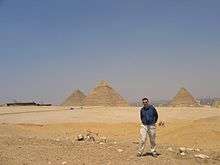
Eicher frequently travels to speak on astronomy or view solar eclipses with tour groups. In 2013 he was invited to speak about great advances in astronomy and on comets at Harvard University, in the Phillips Auditorium of Harvard College Observatory [8]. He was among the 2014 speakers at the Starmus Festival in Tenerife, Canary Islands,[9] and spoke at Harvard again in the spring of 2016, as well as delivering a public talk at Lowell Observatory, Flagstaff, Arizona, in November 2016. In 2017 he spoke at the Science + Mathematics Think-in at WVIZ-PBS ideastream in Cleveland, Ohio [10]. He also spoke at the America’s Darkest Sky Star Party at the Dark Sky New Mexico site near Animas, New Mexico, in April 2017 and October 2017 [11], and in April 2018 delivered the Benson Memorial Lecture in Physics at Miami University in Oxford, Ohio [12].
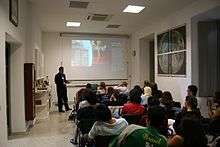
Eicher is active promoting astronomy outreach to a younger generation. From 2011 through 2017, he was president of the Astronomy Foundation (originally titled the Astronomy Outreach Foundation),[13] the first ever trade association for the telescope industry. The Foundation received 501(c)3 nonprofit status in 2014 and included as officers Joseph Lupica, Vic Maris, and Rick Hedrick; its board consisted of Eicher, Lupica, Maris, Hedrick, and others. After serving a six-year term, Eicher resigned as president of the Foundation in 2017 due to time commitments on other projects.
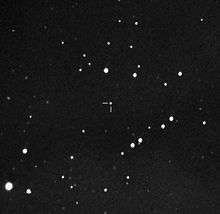
Eicher’s service to the astronomy world was recognized in 1990 when the International Astronomical Union named minor planet 3617 Eicher (discovery designation 1984 LJ) in his honor [14]. The asteroid, a main belt object in orbit between Mars and Jupiter, was discovered by astronomer Brian A. Skiff at Lowell Observatory’s Anderson Mesa Station in 1984 and the citation was proposed and written by astronomer David H. Levy.
Eicher's books include COMETS! Visitors from Deep Space (Cambridge University Press).[15]; a book with Brian May, guitarist and singer from the rock group Queen, and astronomer Garik Israelian, constituting the conference proceedings, lectures, and information from the first Starmus Festival, a science and music event held in 2011 in the Canary Islands; and The New Cosmos: Answering Astronomy’s Big Questions.[16]
Beginning in 2013, he has been a blogger on astronomy and science topics for The Huffington Post.[17] In 2015 he joined the Asteroid Day movement as a 100x signatory and also serves on that project’s board as Editor-in-Chief. [18]
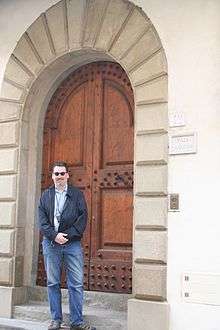
In May 2015 Eicher was named to the Board of Directors of the Starmus Festival[19], joining fellow board members Garik Israelian, Stephen Hawking, Brian May, Peter Gabriel, Alexei Leonov, Richard Dawkins, Jack Szostak, Jill Tarter, and Robert Williams.
In 2015 Eicher began producing a video series addressing realities of astronomy and astrophysics. Titled “The Real Reality Show,” it appears on YouTube and on Astronomy.com.[20] An audio interview series, “Superstars of Astronomy,” features hour-long podcast talks with prominent astronomers, planetary scientists, and cosmologists, including Jeff Hester, Garik Israelian, Martin Rees, Seth Shostak, Debra Fischer, Sara Seager, Heidi Hammel, and others.[21]
In 2016 Eicher edited, along with Garik Israelian and Brian May, the second book of Starmus Festival talks, Starmus: Discovering the Universe, which contains talks from the 2014 Starmus Festival, by Stephen Hawking, Alexei Leonov, Brian May, Mark Boslough, Eicher, Walt Cunningham, John Mather, John Ellis, and others.
In 2017, Eicher started a new audio podcast series “5 Questions with David Eicher,” which is hosted on the Astronomy Magazine website and features interviews about current scientific research with well-known astronomers, planetary scientists, and cosmologists [22]. The first to be interviewed was Alex Filippenko of the University of California-Berkeley. Others include Jeff Hester, Phil Plait, Carolyn Porco, Mark Boslough, Dan Hooper, Alfred McEwen, Sara Seager, Robert Williams, and Jill Tarter.
In June 2017, Eicher joined the Advisory Board of Lowell Observatory, in Flagstaff, Arizona, having been asked by Lowell Putnam, Percival Lowell’s great-grandnephew, the current observatory trustee [23].
Also in June 2017, Eicher attended and was a principal actor at the fourth Starmus Festival, which took place in Trondheim, Norway. Eicher served as host on the Festival’s opening day, delivered two talks about galaxies, served as moderator and host of a panel discussing science education, took part in a Kaspersky Labs panel on the future of Earth, and provided a short film for another Kaspersky Labs project, “Sound of Safety.” [24]
In late June 2017, it was announced that his book, Galaxies, was bought at auction by Clarkson Potter (Penguin Random House), won by editor Jenni Zellner from agent Laura Biagi of the Jean V. Naggar Agency, and that the book will be published in 2019. Publishers Weekly reported the sale in its June 26, 2017 “Book Deals” section.
In January 2018, Eicher and his associate Michael Bakich, Senior Editor of Astronomy, produced the first of a series of DVD and streaming video products, Astronomy Backstage Pass: Chicago. In this three-hour film, Eicher and Bakich provide a behind-the-scenes visit to four major scientific institutions in the Chicago area. They are Adler Planetarium, the Field Museum, Fermilab, and Yerkes Observatory.
In May 2018 it was announced that Eicher has written Mission Moon 3-D, a book containing stereoscopic views of the Moon and with a text covering the Apollo missions, the space race, and the Soviet space program, in association with Brian May and his collaborators. Brian May is listed as Creative Director, with a foreword written by Apollo 16 astronaut Charlie Duke, and an afterword by Apollo 8 and 13 astronaut Jim Lovell. The book is scheduled to be published in October 2018 by the London Stereoscopic Company and MIT Press, and will include Brian May’s celebrated OWL viewer, made for appreciating 3-D images.
Civil War history
Eicher has written eight books on the subject, including Dixie Betrayed (Little, Brown), The Longest Night (Simon and Schuster),[25] Civil War High Commands (Stanford Univ. Press),[26] and The Civil War in Books (Univ. of Illinois Press).
He has also been active in promoting Civil War remembrance and education and was appointed by Wisconsin Governor James Doyle to serve on the state’s Abraham Lincoln Bicentennial Commission in 2009.
In 2013 Eicher donated his Civil War library of more than 4,000 volumes, collected since 1982, to the Ulysses S. Grant Presidential Library and Ulysses S. Grant Association at Mississippi State University. [27]
Personal life
Eicher lives near Big Bend, Wisconsin, with his wife, Lynda Ann Tortomasi Eicher (born May 25, 1961). His son, Christopher David Eicher (born December 18, 1992), is a journalist and videographer.
Eicher has been a drummer since grade school days in Ohio and currently plays with his band, the Astro Blues Band, in Wisconsin, which consists mostly of people who work with Eicher on Astronomy Magazine. The current lineup consists of singer Micki Gebel, singer/harpist Jay Smith, guitarist Keith Bauer, bassist Mike Soliday, and Eicher on drums and occasional vocals [28].
As hobbies go, Eicher is a mineralogist and mineral collector, and has assembled a collection of more than 1,500 aesthetic specimens, mostly assembled between 2004 and 2018. This interest was inspired by the gift of his father’s self-collected ore mineral group, assembled on western trips in the United States between 1926 and 1952. He also is an avid book collector and reader of American and ancient history, as well as other scientific subjects such as archaeology, paleontology, and zoology.
He is an enthusiastic fan of the Green Bay Packers.[29]

Publications
- Galaxies: Inside the Universe’s Star Cities (Clarkson Potter [Penguin Random House], scheduled for publication in 2019)
- Mission Moon 3-D [Brian May, Creative Director, Foreword by Charlie Duke, and Afterword by Jim Lovell] (London Stereoscopic Company and MIT Press, scheduled for publication in October 2018)
- Astronomy Backstage Pass: Chicago (DVD and streaming video product, Kalmbach Publishing Co., 2018)
- 5 Questions with David Eicher[30] (audio podcast interview series, Kalmbach Publishing Co., 2017– )
- Starmus: Discovering the Universe (Executive editor, Canopus Books, 2016)
- The New Cosmos: Answering Astronomy’s Big Questions[31] (Cambridge University Press, 2015)
- Superstars of Astronomy[32] (audio podcast interview series, Kalmbach Publishing Co., 2015–2017)
- The Real Reality Show[33] (video series, Kalmbach Publishing Co., 2015– )
- Starmus: 50 Years of Man in Space (executive editor, Canopus Books, 2014)
- COMETS! Visitors from Deep Space[34] (Cambridge University Press, 2013)
- Astronomy Magazine: The Complete Collection (DVD), including The History of Astronomy Magazine (Kalmbach, 2011)
- Lincoln the Liberal Strategist (Or, a Good Man is Hard to Find) (The Lincoln Fellowship of Wisconsin, 2011)
- A New Birth of Freedom: Abraham Lincoln’s Bicentennial, (1809–2009) (Abraham Lincoln Bicentennial Commission, 2009)
- 50 Greatest Mysteries of the Universe (Kalmbach, 2007)
- Dixie Betrayed: How the Confederacy Really Lost the Civil War (Little Brown, 2006)
- Beginner’s Guide to Astronomy (Kalmbach, 2003)
- Gettysburg Battlefield: The Definitive Photographic History (Chronicle Books, 2003)
- The Longest Night: A Military History of the Civil War[35] (Simon and Schuster, 2001)
- Civil War High Commands[36] (coauthor, with John H. Eicher, Stanford University Press, 2001)
- Mystic Chords of Memory: Civil War Battlefields and Historic Sites Recaptured[37] (Louisiana State University Press, 1998)
- Robert E. Lee: A Life Portrait (Taylor, 1997)
- The Civil War in Books: An Analytical Bibliography (University of Illinois Press, 1997)
- Civil War Battlefields: A Touring Guide (Taylor, 1995)
- Beginner’s Guide to Amateur Astronomy (Kalmbach, 1993)
- The New Cosmos: The Astronomy of Our Galaxy and Beyond (editor, Kalmbach, 1992)
- Galaxies and the Universe: An Observing Guide from Deep Sky Magazine (editor and coauthor, Kalmbach, 1992)
- Stars and Galaxies: Astronomy’s Guide to Observing the Cosmos (editor and coauthor, Kalmbach, 1992)
- Beyond the Solar System: 100 Best Deep-Sky Objects for Amateur Astronomers (Kalmbach, 1992)
- Civil War Journeys calendar (Tide-mark, 1990–2000)
- Deep Sky Observing with Small Telescopes (Enslow, 1989)
- The Universe from Your Backyard (Cambridge University Press, 1988)
References
- ↑ May, Hal, ed.: Contemporary Authors, vol. 113, page 141, Gale Research Co., Detroit, Michigan, 1985;
- ↑ May, Hal, ed.: Contemporary Authors, vol. 113, page 141, Gale Research Co., Detroit, Michigan, 1985;
- ↑ "Magazine History". Astronomy.com. Retrieved 2017-10-20.
- ↑ "Kalmbach Publishing Co. - About Kalmbach". www.kalmbach.com. Retrieved 2017-10-20.
- ↑ "Astronomy Magazine History". Astronomy Magazine. Retrieved 7 May 2016.
- ↑ "Astronomy Magazine Staff". Astronomy Magazine. Retrieved 7 May 2016.
- ↑ CNN Headine News, September 8, 2004, August 31, 2004, June 8, 2004, May 14, 2004, March 15, 2004, January 14, 2004, November 7, 2003, and August 26, 2003; Next@CNN, July 6, 2003; CNN, August 27, 2003; CNN Saturday, August 23, 2003; CNN International, March 4, 2003; Fox News Channel, May 11, 2004; National Public Radio Morning Edition June 8, 2004; WGN Radio, Steve and Johnnie Show July 6, 2004; WGN Radio Nick D and Garry Lee Show June 25, 2004; WGN Milt Rosenberg Show September 27, 2002.
- ↑ ""10 Great Discoveries," David Eicher, Editor-in-Chief, Astronomy magazine". Harvard Smithsonian Center for Astrophysics. September 19, 2013. Retrieved October 19, 2017.
- ↑ "Starmus Festival 2014". Starmus Festival. Retrieved 7 May 2016.
- ↑ "Science + Mathematics Think-In". ideastream. 2017-03-23. Retrieved 2017-10-19.
- ↑ "America's Darkest Sky Star Party a Smashing Success - Astronomy Magazine - Interactive Star Charts, Planets, Meteors, Comets, Telescopes". cs.astronomy.com. Retrieved 2017-10-19.
- ↑ "David Eicher to deliver Miami University Benson Memorial Lecture - Astronomy Magazine - Interactive Star Charts, Planets, Meteors, Comets, Telescopes". cs.astronomy.com. Retrieved 2017-10-19.
- ↑ "About the Astronomy Foundation". Astronomy Foundation. Retrieved 7 May 2016.
- ↑ Chamberlin, Alan. "JPL Small-Body Database Browser". ssd.jpl.nasa.gov. Retrieved 2017-10-19.
- ↑ "COMETS!". Cambridge University Press. Retrieved 2016-05-10.
- ↑ "The New Cosmos by Cambridge University Press". Cambridge University Press. Retrieved 7 May 2016.
- ↑ "David J Eicher on The Huffington Post". The Huffington Post. Retrieved 7 May 2016.
- ↑ "Asteroid Day Team". Asteroid Day. Retrieved 7 May 2016.
- ↑ "David J Eicher - Official Profile - Asteroid Day". Asteroid Day. Retrieved 2017-10-19.
- ↑ "The Real Reality Show". Astronomy Magazine. Retrieved 10 May 2016.
- ↑ "Superstars of Astronomy Podcast". Superstars of Astronomy Podcast. Astronomy Magazine. Retrieved 10 May 2016.
- ↑ "Five Questions with David J Eicher". Astronomy.com. Retrieved 2017-10-19.
- ↑ "David Eicher joins Lowell Observatory Board - Astronomy Magazine - Interactive Star Charts, Planets, Meteors, Comets, Telescopes". cs.astronomy.com. Retrieved 2017-10-19.
- ↑ "SPEAKERS". STARMUS. Retrieved 2017-10-19.
- ↑ "The Longest Night". books.simonandschuster.com. 2002-09-04. Retrieved 2016-05-10.
- ↑ Press, Stanford University. "Civil War High Commands". www.sup.org. Retrieved 2016-05-10.
- ↑ Henderson, Meg (Summer 2014). "Eicher Gives Large Book Collection to Grant Library by Meg Henderson" (PDF). Dispatches from Grant: The Newsletter of the Ulysses S. Grant Presidential Library at Mississippi State University. Retrieved October 19, 2017.
- ↑ "Astronomy Blues Band". Reverb Nation. Retrieved 2017-10-19.
- ↑ David J. Eicher (ed.). "HOUSTON, WE'VE HAD A PROBLEM". astronomy.com. Retrieved 2015-11-16.
- ↑ "Five Questions with David J Eicher". Astronomy.com. Retrieved 2017-10-19.
- ↑ "New cosmos answering astronomys big questions | Amateur and popular astronomy". Cambridge University Press. Retrieved 2017-10-19.
- ↑ "Superstars of Astronomy Podcast". Astronomy.com. Retrieved 2017-10-19.
- ↑ "The Real Reality Show". Astronomy.com. Retrieved 2017-10-19.
- ↑ "COMETS!, Visitors from Deep Space". Cambridge University Press. Retrieved 2017-10-19.
- ↑ Eicher, David (2002). The Longest Night: A Military History of the Civil War. Simon & Schuster. ISBN 9780743218467.
- ↑ Eicher, David (2002). Civil War High Commands. Stanford, CA: Stanford University Press. ISBN 9780804736411.
- ↑ Eicher, David (1998). Mystic Chords of Memory: Civil War Battlefields and Historic Sites Recaptured. Chapel Hill, NC: Louisiana State University Press. ISBN 0807123099.